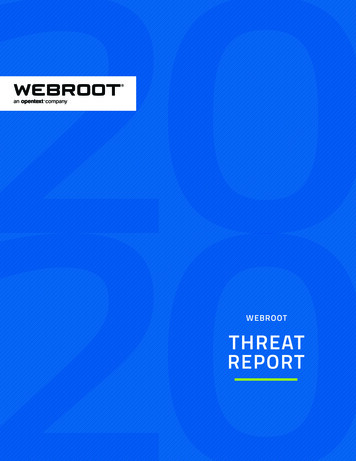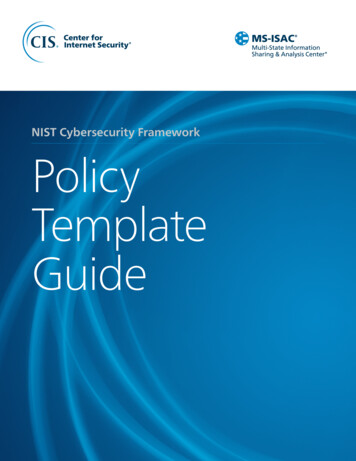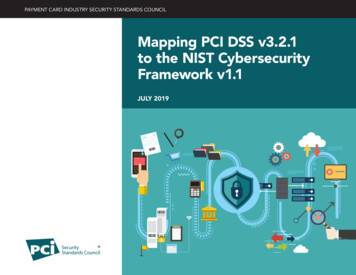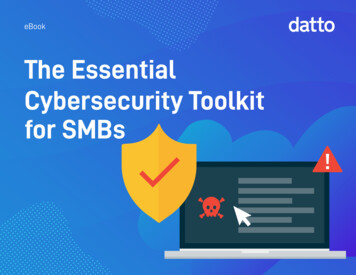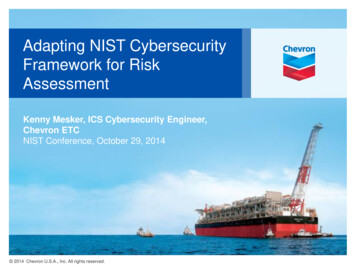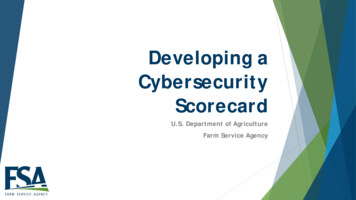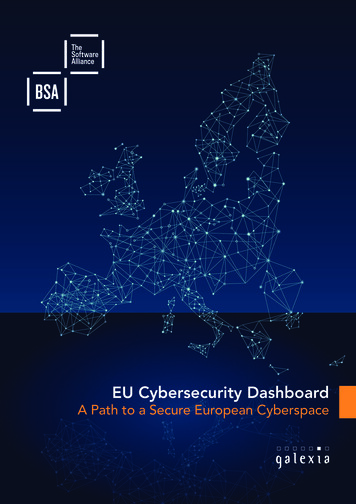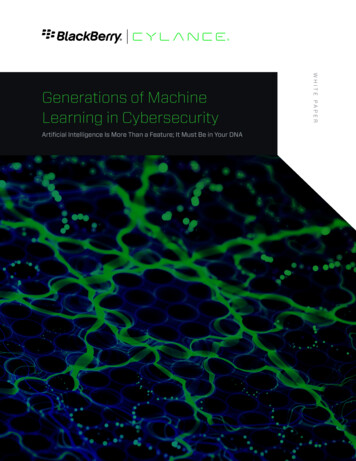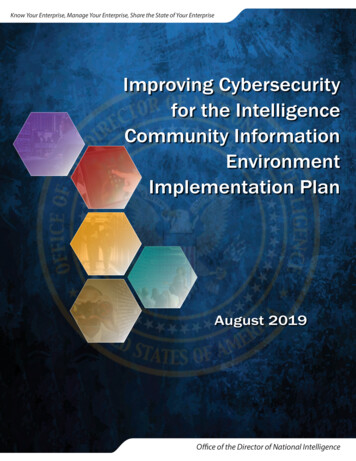
Transcription
Know Your Enterprise, Manage Your Enterprise, Share the State of Your EnterpriseImproving Cybersecurityfor the IntelligenceCommunity InformationEnvironmentImplementation PlanAugust 2019Office of the Director of National Intelligence
TABLE OF CONTENTSBACKGROUND.1INTRODUCTION.2FUNCTIONAL FRAMEWORK.4OBJECTIVES AND TASKS.8IMPLEMENTATION. 10INFORMATION TECHNOLOGY MANAGEMENT. 13ENTERPRISE SAFEGUARDING CAPABILITIES. 25THREAT INTELLIGENCE SHARING. 33CYBER CAPACITY. 39CYBER CONTROLS. 45APPENDICESA – TASK SOURCES. 51B – INDEX OF TASKS BY CHAMPION. 52C – ACRONYMS AND ABBREVIATIONS. 53
Message from the Director of NationalIntelligenceWe face a perfect storm comprised of information technology (IT)vulnerabilities associated with the proliferation of software and networktechnologies; increasing reliance on foreign-owned, manufactured, orcontrolled hardware, software, and services; and adversaries’ increasinglypersistent and sophisticated asymmetric cyberattacks. Their focus – UnitedStates (U.S.) Government agencies; academic and research institutions;our critical infrastructure; and commercial enterprises in the U.S. IT supplychain. Adversaries strive to outpace us in advanced technology, render ourtechnologies unreliable, and steal our intellectual property.The increased and pronounced ransomware attacks, massive databreaches, and supply chain attacks in the commercial sector are disturbingtrends that very possibly could infiltrate our secure IT environments.Recent compromises of managed service providers and legitimate softwareallowed cyber adversaries to cause large-scale disruptions toU.S. infrastructure. In response to these events, the President issuedExecutive Order 13800, Strengthening the Cybersecurity of FederalNetworks and Critical Infrastructure, on 11 May 2017, requiring the federalgovernment to enhance its agility to detect, understand, characterize,and share information about cyber threats supporting national securitydecision making.Daniel R. CoatsDirector of NationalIntelligenceAs an Intelligence Community (IC), we must collectively improve ourcybersecurity posture and enhance our cyber defenses to ensure thesecurity of our intelligence networks and systems. Each IC element mustrecognize its role in a secure, connected, data-centric, integrated, andtransparent technology environment in which shared cybersecurityintelligence benefits the entire enterprise.This plan for improving IC cybersecurity constitutes collaboration betweenthe Office of the Intelligence Community Chief Information Officer,National Counterintelligence and Security Center, National IntelligenceManager – Cyber, Intelligence Community Security Coordination Center,and all 17 members of the IC. We appreciate your participation andcontinued engagement.The Director of National Intelligence shall oversee IC element information security policies and practices, including:(1) Developing and overseeing the implementation of policies, principles, standards, and guidelines oninformation security;(2) Requiring [IC elements] to identify and provide information security protections commensurate withthe risk and magnitude of the harm resulting from the unauthorized access, use, disclosure, disruption,modification, or destruction of information collected or maintains by or on behalf of an [IC element]; orinformation systems used or operated by an [IC element] or by a contractor of an [IC element] or otherorganization on behalf of an [IC element].*Federal Information Security Modernization Act (FISMA) of 2014 §3553
Message from the IntelligenceCommunity Chief Information Officerand Intelligence Community ChiefInformation Security OfficerThe IC is undergoing unprecedented transformation. Managing a fluidgeopolitical environment requires the IC to be agile in delivering IT systemsand thoughtful in sharing intelligence information. IC elements continueto find new ways to collaborate, coordinate, and share informationacross agencies and with non-traditional partners. Modernizing the IC’sIT infrastructure enables this transformation and leverages increasinglysophisticated technology.John B. ShermanIntelligence CommunityChief Information OfficerThe rapid assimilation of new services, software, and raw and finishedintelligence products are dramatically changing the way the IC needs tosafeguard its data. As the mission expands, the IC needs to understandand respond to the holistic risk presented by operating in the sameinterconnected cyber environment that our adversaries target. For thisreason, we must unite in securing the Intelligence Community InformationEnvironment (IC IE).Meeting the objectives detailed in this plan requires unprecedentedpartnership and understanding among senior leadership; cyber,cybersecurity and IT professionals; mission leadership; program managers;acquisition executives; supply chain and cyber threat analysts; andcounterintelligence experts. We are excited at the opportunity to engagewith the Community to work on such an important initiative.Susan T. DorrIntelligence CommunityChief InformationSecurity OfficerThe Director of National Intelligence has authority over systems that are operated by an [IC element], oranother entity on behalf of an [IC element] that processes any information the unauthorized access, use,disclosure, disruption, modification, or destruction of which would have a debilitating impact on the missionof an [IC element].**Federal Information Security Modernization Act (FISMA) of 2014 §3553The IC CIO is responsible for developing and overseeing the implementation and IC element adoption of policies,principles, standards and guidelines on information security promulgated for national security systems asauthorized by law and directed by the President and to identify and provide information security protectionscommensurate with risk consistent with the information security requirements established by Subchapter IIIof FISMA.**Intelligence Community Directive 500
PURPOSEThis implementation plan establishes aframework of cybersecurity objectives andtasks where IC elements can focus their limitedresources to address modern threats andmitigate the highest risks to the IC IE
Improving the Security Posture of the IC IESafeguarding the Intelligence Community Information Environment (IC IE) is afundamental component of the National Intelligence Strategy. Per law, order, regulation,and policy, all 17 elements of the Intelligence Community (IC) must secure and protectthe people, information, and enterprise, mission, and business information technology(IT) that are so vital to intelligence mission success.On 12 February 2018, the Principal Deputy Director of National Intelligence (PDDNI),Susan Gordon, directed the Intelligence Community Chief Information Officer (IC CIO) todevelop this plan in collaboration with IC elements and other components of the Officeof the Director of National Intelligence (ODNI) in response to: A series of recent unauthorized disclosures;Multiple annual IC element Chief Information Officer (CIO) and Inspector GeneralFederal Information Security Modernization Act (FISMA) reports indicatingdeficiencies in managing and maintaining vulnerability management (VM)programs and basic computer hygiene; andA National Intelligence Council Memorandum issued in December 2017 thathighlighted the top cyber risks and threats to the intelligence mission.The intent of this implementation plan is to: Identify the fundamental, common, and maturing tasks of greatest importance tosafeguard the IC IE;Raise awareness of the various roles and authorities across the elements thatmust collaboratively engage in executing IC IE cybersecurity activities; andFoster ongoing conversations about enterprise security risks and the balance ofinvestment and sustainment to mature the IC IE safeguarding posture.The IC IE includes the individuals, organizations, and IT capabilities that collect, process, or share SensitiveCompartmented Information (SCI), or that, regardless of classification, are operated by the IC and are in whole or inmajority funded by the National Intelligence Program.**Intelligence Community Directive 121, Managing the Intelligence Community Information Environment1BACKGROUNDBACKGROUND
INTRODUCTIONImproving the Security Posture of the IC IEINTRODUCTIONOur adversaries are actively attempting to exploit cyberspace. The IC’s dynamic ITenvironment provides unique cybersecurity challenges in countering this threatlandscape. There are numerous facets to responding to our adversaries efforts, bothoffensive and defensive.This Implementation Plan focuses on safeguarding the IC IE through the disciplines ofroutine computer hygiene, asset and configuration management, and cybersecurity.Several of these are included as guidance to IC elements in the Consolidated IntelligenceGuidance Fiscal Years 2021-2025, recently signed by the DNI and USD(I). According tothe National Initiative for Cybersecurity Careers and Studies, cybersecurity is the “activityor process, ability or capability, or state whereby information and communicationssystems and the information contained therein are protected from and/or defendedagainst damage, unauthorized use or modification, or exploitation.”The most significant efforts towards defending the IC IE should focus on the fundamentalcybersecurity principles listed below. Industry thought leaders, such as the SANSInstitute, indicate that organizations can mitigate over eighty percent of cybersecurityvulnerabilities by performing basic computer patching and hygiene. This requiresmature and comprehensive efforts to know, manage, and share the state of theenterprise, including all enterprise, business, and mission IT.Fundamental Cybersecurity PrinciplesKnow your enterpriseMaintain a complete inventory of all enterprise, mission, and business hardware andsoftware, coupled with network maps, topologies, and data.Manage your enterpriseKeep hardware and software current by installing security patches, updating software, andupgrading old or deprecated hardware and software. Harden operating systemconfigurations per standards. Execute routine computer hygiene to identify deficiencies.Share the state of your enterpriseShare agreed-to data, key performance indicators, and event metrics that support the ICIE’s overall health and security status. Openly report and provide this data to the ICSecurity Coordination Center for correlation and management of a holistic and shared ICcybersecurity situational awareness.While these fundamental principles provide basic security, they are insufficient toaddress the full scope of threats. The IC must leverage complementary securitydisciplines, to include human, physical infrastructure, and technological, to ensure end2
Improving the Security Posture of the IC IEIC elements are improving their respective security postures; however, these effortsdo not address the IC IE’s connected nature and only marginally improve the enterprise.The Consolidated Intelligence Guidance (CIG) for Fiscal Year (FY) 2020-2024 highlightsthis realization, “IC elements must resolve long-standing barriers to successfulimplementation of a shared secured information environment in which all elementsparticipate and proactively protect for the benefit of integrated intelligencemission operations.”This Implementation Plan identifies a number of objectives and tasks for improving thecybersecurity of the IC IE, while balancing risk tolerance against mission delivery. The ICmust augment and leverage existing capabilities, expertise, and insights as a collectivebody to defend against advanced persistent threats.Key Implementation Plan Assumptions Scope – All enterprise, business, and mission IT assets, data and datasets, both classified andunclassified, including IT assets associated with U.S. information systems and partnershipinformation systems (as defined in IC Standard 503-04, Managing Non-U.S. Personal Access toInformation Systems) and those that cross network security boundaries. Agreement – The IC collectively agrees on a set of cybersecurity initiatives against which resourcetradeoffs with mission capabilities must be made. Collaboration – The IC will collaborate on solutions and areas of common interest to enhance IC IEcybersecurity. Technology – The IC will adopt and integrate advanced technology (e.g., artificialintelligence/machine learning) necessary to predict and identify threats and proactively mitigatevulnerabilities. Maturation – The IC will adjust strategy, policy, and budgets in response to maturing technologiesand processes. Management – The IC will normalize fundamental and repeatable aspects of IT management acrossthe IC for both reporting on cybersecurity performance status and responding to occurring threats. Strategy – The IC will develop a higher order cybersecurity strategy to respond to the NationalIntelligence Strategy and CIG strategic outcomes, while driving this Implementation Plan. Workforce –The IC will identify, expand, recruit, develop, retain, and sustain a cybersecurityworkforce with the knowledge, skills, and abilities to respond to cybersecurity challenges.3INTRODUCTIONto-end safeguarding. Additional activities currently underway, such as maturing supplychain processes, articulating data protection requirements, and reducing unauthorizeddisclosures significantly contribute to holistic efforts to manage risk.
FUNCTIONAL FRAMEWORKImproving the Security Posture of the IC IEFUNCTIONAL FRAMEWORKThe IC Chief Information Security Officer (IC CISO) and IC element CISOs identifiedthirteen objectives spanning five functional areas.Informa on Technology ManagementImprove Hardware &So ware AssetManagementImprove VulnerabilityManagementEnhance IncidentResponse ProgramImprove Con nuity ofOpera ons & DisasterRecoveryImprove Cybersecurity Situa onal AwarenessEnterprise SafeguardingCapabili esImprove Data Protec on& TrackingImprove Iden ty,Creden al, and AccessManagementThreat IntelligenceSharingImprove Analysis &Sharingof User Ac vity,Monitoring& Audit DataImprove A en on tothe Supply ChainCyberCapacityStrengthen Cyber WorkforceImprove Availability ofThreat IntelligenceCyberControlsImprove Cyber Programma cOversightImprove Enterprise RiskManagement ProcessesIC Cybersecurity Implementation Plan Functional FrameworkThese objectives emphasize recurring themes identified by IC elements in annual FISMAand Integrated Defense of the IC Information Environment reporting. The CISOs identifiedthese objectives as the most relevant items to reduce cybersecurity risks and achieve animproved and mature IC IE.Key interdependencies exist between the thirteen objectives. For example,Improve Attention to the Supply Chain requires secure, standardized processesand architecture that ensures the integrity of vendor software updates to ImproveVulnerability Management.4
Improving the Security Posture of the IC IEManaging information technology is a joint responsibility of IT andsecurity professionals. Cybersecurity responsibilities extend throughoutthe organization, possibly to individuals in roles not accustomedto thinking of themselves as part of the security practice. Fromthe cybersecurity perspective encompassed in this plan, securityprofessionals include not only the typical information systemssecurity engineers and operators, but also business professionals, such as programmanagers (PMs) and acquisition executives, who all must take active roles in the largerorganizational and enterprise safeguarding objectives.Performing basic hardware and software asset management is critical to understandingand measuring improvements in an organizational cybersecurity baseline andsafeguarding posture. Preventing exploits against known vulnerabilities within andamong known and managed IT assets is imperative. Performing proactive prediction,identification, and response to security incidents happening to known and managed ITassets is critical to limiting potential damage. Continuing to operate or recover knownand managed IT assets during and after natural disasters or cyberattacks ensuresmission performance during extreme circumstances. Maintaining IC-wide cybersecuritysituational awareness of vulnerabilities to and events against known and managedIT assets, as well as our response to human or natural threats to operations, keepsIC leadership and security professionals as a collective whole in a continuous state ofpreparation, response, and informed decision-making.FUNCTION: ENTERPRISE SAFEGUARDING CAPABILITIESFundamental to the IC’s secure cloud services architecture isthe concept of “tag the data, tag the people, and audit user andsystem activities.” Maintaining data and information that is known,standardized, and self-describing with metadata for discovery, accessrights, and handling postures IC data holdings for maximum discoveryand appropriate access and retrieval. Providing a common, sharable5FUNCTIONAL FRAMEWORKFUNCTION: INFORMATION TECHNOLOGY MANAGEMENT
FUNCTIONAL FRAMEWORKImproving the Security Posture of the IC IEmethod for managing identities, attributes, and entitlements for person entitiesand non-person entities enables access decision systems to grant users and systemsappropriate access to data and other systems. Auditing user and system activities andfeeding event data to and alerting appropriate individuals responsible for monitoringmalicious behavior and performing counterintelligence functions provides an importantaspect of IT monitoring for unauthorized disclosures and intentional threats.Implementation of these architectural and engineering approaches at both theorganizational and enterprise levels continues to be a work in progress, with enablingmission and business systems remaining a significant challenge. The IC is federatingsolutions across the enterprise to provide consistency across all IC users and systems.The Intelligence Community Chief Data Officer collaborates with IC element Chief DataOfficers (CDO) to advance common data reference architectures, standards, and datamanagement practices, and data services to posture IC data holdings for data scienceand augmented intelligence. However, inconsistent implementation of these approacheswill increase data protection gaps and vulnerabilities within the enterprise, therebyincreasing the efforts across other plan objectives to mitigate security risks.FUNCTION: THREAT INTELLIGENCE SHARINGAdversaries continue to enhance their cyber capabilities to compromisesensitive information, alter data, and disrupt or destroy systems.The President’s 11 May 2017 Executive Order 13800, Strengtheningthe Cybersecurity of Federal Networks and Critical Infrastructure,called upon the Federal Government to enhance its agility to detect,understand, characterize, and share information about cyber threats in support ofenabling comprehensive security risk decision-making.This function focuses on two primary forms of threat intelligence that feed theInformation Technology Management and Cyber Control objectives. Intelligenceregarding supply chain threats and other cyber threat actors
information systems used or operated by an [IC element] or by a contractor of an [IC element] or other . standards and guidelines on information security promulgated for national security systems as . . Several of these are included as guidance to IC e
